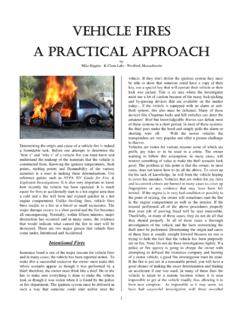Transcription of Module One - Information sources
1 Module One - Information sources Introduction Information is power and an essential ingredient in decision-making. To obtain timely, relevant and quality Information for your study or research work, you need to know the various sources of Information available. This Module is expected to deepen your knowledge of sources of Information in print, non- print and electronic formats. It presents the definition, originators/producers, types, formats, and categories of Information sources . The Module also shows where Information sources could be found archives, libraries and the Internet. Learning Objectives Students/Trainees would learn: 1. The definition of Information sources 2. The major producers of Information sources 3. Types of Information sources 4. The formats of Information sources 5. Where to find Information sources 6. Categories of Information sources 7.
2 Internet Information sources Learning Outcomes At the end of the Module , students/trainees should be able to: 1. Define Information sources 2. Identify and list producers/originators of Information 3. Determine types of Information sources 4. List formats of Information sources 5. Determine where to find Information sources 6. List and discuss the categories of Information sources 7. Identify and use Internet Information sources Table 1: Summary of Content S/N Content Methods Mode of Assessment Definition of Information / Information sources Lecture Discussion Brainstorming Question and Answers Producers and originators of Information sources Lecture Brainstorming Pre and post test Question and Answers Types of Information sources Brainstorming Discussion Question and Answers Formats of Information sources Brainstorming Lecture Discussion Assignment Where to find sources of Information Brain storming Discussion Question and Answer Categories of Information sources Brainstorming Discussion Question and Answers Internet Information sources Discussion Lecture Brainstorming Question and Answers Handson Producers/Originators of Information There are three main producers/originators of Information .
3 These are: 1. Government Agencies 2. Academic institutions 3. The private Sector 4. Individuals Government Agencies Government departments and agencies publish lots of Information in print and electronic formats. In various countries of the world, governments at all levels play an important role in producing Information for the society they serve. In many occasions, government officials may need Information about the society in order to make decisions relating to economic, social and political issues [1]. Some of the Information produced by government is grey literature comprising reports such as National HIV/AIDS reports, gazettes, population statistics, census data, government notices, policy documents etc. Since government documents are generated with public funds, they are made available either free of charge or at low cost. This can be done through the various government agencies including the public libraries or the government Websites.
4 In Nigerian for instance, some government departments and agencies Websites include: National Agency for the Control of AIDS (NACA), National Bureau of Statistics (NBS), Federal Ministry of Information and Culture (FMIC), Academic institutions Academic institutions such as universities and colleges are major producers of Information in a society or country. Academic institutions around the world especially those in the United States (Yale, MIT, Harvard, Johns Hopkins, Stanford, University of North Carolina at Chapel Hill, University of Wisconsin and University of California, Los Angeles etc), United Kingdom (Cambridge, Oxford, University of Liverpool) Africa (University of Ibadan, Nigeria; University of Zimbabwe; University of Zambia; Makerere University, Uganda; Kenyatta University, Nairobi; University of Bamako, University of Witwatersrand, South Africa, and University of Ghana, Legion etc) have conducted extensive researches in various specialties including the health sciences.
5 Numerous publications and knowledge materials are generated from these research studies as technical reports, books and articles in peer reviewed journals. Academic institutions also have other publications such as Newsletters, Magazines, Technical reports, Manuscripts, Maps and lots of other Grey literature. Web addresses of some academic institutions in Africa are listed below: University of Ibadan, Nigeria University of Zambia- Kenyatta University, Nairobi, Kenya- University of Zimbabwe Makerere University, Uganda University of Bamako, Mali - Private Sectors A third major producer of Information in a country is the private sector. This consists of print and electronic media organizations, commercial business outfits, publishers/vendors and aggregators, performing /film industry that publish and or make their Information products and services accessible on the Web either free or by subscription.
6 Others are: Non-profit professional organizations Profitable organizations and commercial agencies International Agencies Professional Associations or organizations Private institutions Corporate laboratories Unlike government departments and agencies, published reports of research carried out by most organizations, agencies and commercial outfits in the private sector are not made available for public consumption. However, non- profit organizations and agencies do make their publications available to those that need them. Some examples of agencies in the private sector or non profit category are: The World Health Organization (WHO) Joint United Nations Program on HIV and AIDS (UNAIDS) Elsevier Publishers Cables News Network (CNN) Private Individuals Individuals also create Information . Many print and web documents available today are created by private individuals, some of whom have their own Websites/pages.
7 Some individuals disseminate Information through Facebook, Twitter, Blogs, You-tube etc, while others publish Information in print as text books, monographs or articles in journals, magazines or newsletters. On the other hand, some important Information is not published rather, it is passed on from generation to generation. For example, some parents pass Information to their children by word of mouth on how diseases were treated using traditional unorthodox methods in their communities. Exercises 1. List the various producers of Information in a country. 2. Give three examples of the type of Information each produces or creates. Definition of Information / Information sources Information is processed data. An Information source is where you got your Information from; this can be a book or a Website. Information sources are the various means by which Information is recorded for use by an individual or an organization.
8 It is the means by which a person is informed about something or knowledge is availed to someone, a group of people or an organization. Information sources can be observations, people, speeches, documents, pictures, organizations. Information sources can be in print, non-print and electronic media or format. Types of Information sources Information can come from virtually anywhere: personal experiences, books, articles, expert opinions, encyclopedias, the Web. The type of Information needed will change depending on its application. Individuals generate Information on a daily basis as they go about their work. In academic institutions, staff and students consult various sources of Information . The choice of the source to consulted is usually determined by the type of Information sought. The three types of Information sources are: Primary Secondary Tertiary Primary sources Primary sources are original materials on which other research studies are based.
9 Primary sources report a discovery or share new Information [2]; they present first-hand accounts and Information relevant to an event [3, 4a and 5]. They present Information in its original form, not interpreted or condensed or evaluated by other writers [2]. They are usually evidence or accounts of the events, practices, or conditions being researched [4a, 6] and created by a person who directly experienced that event [7]. Primary sources are the first formal appearance of results in print or electronic formats [3]. Examples of primary sources are: eyewitness accounts, journalistic reports, financial reports, government documents, archeological and biological evidence, court records, ephemerals (posters, handbills), literary manuscript and minutes of meetings etc [3,4b and 6]. The definition of a primary source may vary depending upon the discipline or context.
10 A diary would be a primary source because it is written directly by the individual writing in the diary [7]. Interviews are primary sources because the individual talks about the topic directly from what he/she knows about it. Other examples are: Video of the inauguration of the first female president in Brazil A scientific publication reporting the development of a new medication to manage patients with sickle-cell anemia Print - Diaries - Letters - Speeches - Patents - Photographs - Newspaper articles - Journal articles - Theses and dissertations - Survey Research ( , market surveys, public opinion polls) - Proceedings of Meetings, conferences and symposia - Original Documents ( birth certificates, wills, marriage licenses, trial transcripts) - Records of organizations, government agencies ( annual reports, treaties, constitutions, government documents) Electronic Internet E-mail communication Communication in Listservs Interviews ( , telephone, e-mail) Video recordings ( television programs) Audio recordings ( radio programs)


